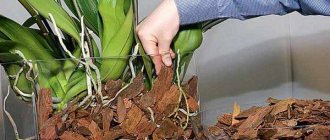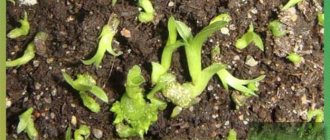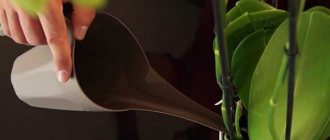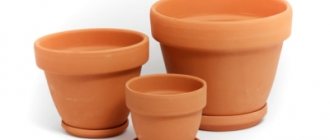The purpose of using growth stimulants when growing orchids
The issue of using stimulants when growing orchids is a very delicate one. Some experts do not recommend getting carried away with them, considering artificial stimulation harmful to epiphytes:
“Stimulants must be handled carefully. Often gardeners squeeze all the reserves out of a plant, and then are surprised that their orchids quickly age and stop blooming. Epiphytes, in fact, grow and bloom beautifully without any stimulants, if you create the right conditions for them - good light and aeration of the roots, proper watering and moderate mineral supplements.”
A. Davydovskaya, owner of the orchidarium
However, in practice, it is not always possible to create ideal conditions for orchids. Plants stop growing, freeze in the dormant phase, refuse to bloom, and get sick. Therefore, from time to time you have to resort to stimulation.
Classification of stimulants by active ingredients
The active components of growth stimulants may be different. On this basis they are classified as follows:
| Active components of the stimulant | Effect on orchids | Purpose |
| Phytohormones auxins, cytokinins, gibberellins | They activate the elongation and division of stem or root cells, the formation of buds, and accelerate flowering. | Stimulation of growth and flowering of orchids. |
| Phytohormones brassinosteroids | They stimulate the development of seedlings and support immunity in unfavorable conditions. | Relieving stress after exposure to adverse factors, increasing resilience. |
| Vitamins | They enhance the circulation of nutrients in tissues, affect the formation of enzymes, the intensity of photosynthesis, and relieve the consequences of harmful influences. | Stimulates growth and flowering, increases resistance to adverse factors, restores immunity after stress and illness. |
| Amino acids | They increase resistance to osmotic or temperature stress, regulate the functioning of stomata, stimulate the synthesis of their own phytohormones, increase resistance to infections, and activate growth and flowering. | Stimulation of growth and flowering, root formation, increasing resistance to adverse factors, restoration of the lost root system. |
| Organic acids (succinic, citric, malic) | They improve cellular respiration, enhance mitochondrial function and metabolism, accelerate the formation of roots and shoots, increase the length of peduncles, the number and diameter of flowers. | Stimulation of growth and flowering, increasing resistance to adverse factors. |
| Microelements | They influence all biochemical processes, participate in the construction of cells, activate photosynthesis and nutrient transport. | Stimulation of growth and flowering, elimination of mineral starvation, increasing the decorativeness of orchids. |
| Glucose | It is a source of energy for cells, participates in the formation and storage of its own sugars. | Restoration of weakened orchids that have lost leaf turgor, stimulation of their growth, adaptation to lack of irrigation. |
From the table above it is clear that the stimulating effect can be produced in different ways. Some stimulants cause cells to rapidly divide and stretch, others act more gently by increasing the metabolic rate and improving the nutrition of orchids.
Reader Questions
In what cases is it best to stop feeding altogether?
Additional food should not :
- After transplantation, until the flower is completely acclimatized;
- Sick and weak plant;
- On dry roots;
- Most gardeners do not recommend feeding during the flowering period.
Important! Fertilizers should be used only during the active process of photosynthesis, i.e. when the leaves and root parts are in the growth stage.
Why does too much fertilizing shorten the flowering time of orchids?
The opinions of flower growers on this issue differ . Some people believe that additional nutrition does not affect the duration of flowering, while others, on the contrary, are sure that it shortens this period.
Most orchidists tend to believe that the second option is preferable.
It would probably be right if you choose the middle. If you give a flowering agent, then significantly reduce its use and concentration. Since the plant spends too much energy during such an important period for it and the grower.
Growth stimulants based on phytohormones
This is the most popular, but also the most problematic group of growth stimulants. The peculiarity of phytohormones is that when they are in excess, they can have the exact opposite, inhibitory effect on plants. Orchids are more sensitive to such influences than other plants, so such preparations must be used very carefully when growing them.
Phytohormonal stimulants should be used strictly according to the instructions, avoiding overdose, and only when absolutely necessary. To reduce the likelihood of negative consequences, you simultaneously need to feed orchids and adjust lighting, air temperature and irrigation frequency
The most famous and effective phytohormonal stimulants are the following:
- Heteroauxin. Often used to stimulate the growth of the root system during the resuscitation of orchids. Available in powder or tablet form. The average cost of a package is 30 rubles.
- "Bud". The drug is based on the phytohormone gibberellin. It is used to stimulate the flowering of orchids and increase the number of flowers on the peduncle. Available in water-soluble form. The average price of a package is 40 rubles.
- Cytokinin paste. Used to activate the formation of peduncles or children, to stimulate the opening of the lateral buds of the orchid. Produced by many manufacturers at prices ranging from 80 to 150 rubles.
- "Epin-Extra". The safest of the hormonal stimulants, based on epibrassinolide, is a phytohormone from the group of brassinosteroids. It is used to increase the immunity of orchids, improve their adaptation and growth rate. Available in the form of a solution at a price of 15-20 rubles per ampoule.
Slightly less often, orchid lovers use such drugs from this group as “Ovary”, “Kornevin”, “Gibbersib”.
Preparing for resuscitation
Root growth of phalaenopsis in water will be successful only if the preparatory process is correct:
- Carefully remove from the pot and get rid of the substrate to find out how damaged the root is. The root system is washed.
- Select the parts that will be removed. Roots that are still light green in color, have good texture and leave. It is important to consider that healthy roots may be whitish; this happens when little sunlight gets into the pot. The roots to be removed will be beige with a brown tint.
- Damaged leaves of the plant that look wilted should not be touched. The orchid itself will get rid of them when the time comes.
- Peduncles can be safely removed. They will be responsible for the fact that the roots grow slowly, because the plant will put more energy into the flower stalks. The maximum that can be left is the lower part.
- All excess parts are removed with sterile instruments. At this stage, areas that indicate rot or dryness can be removed from healthy leaves.
- The cut needs processing. This is necessary in order to avoid possible rotting. The rotting process can completely kill a plant in just a couple of days
- Treatment is carried out with ash, cinnamon or activated carbon. Many also use charcoal or a fungicide for these purposes (in the case of the latter, soaking is carried out for no longer than 15 minutes, the dosage is halved, based on what the manufacturer recommends). It is forbidden to use brilliant green or iodine. Such products will only cause harm to the plant, in the form of burns.
- The last stage is drying. This does not take much time: from half an hour to several hours.
All these steps cannot be skipped if you want to know how to revive a phalaenopsis orchid when its roots have dried out.
The use of vitamins to stimulate the growth of orchids
Experienced lovers of epiphytes often use ordinary pharmacy vitamins in ampoules to stimulate the development and strengthen the immunity of orchids. The most effective in this regard are the following:
- vitamin C;
- B vitamins (B1, B6, B12);
- nicotinic acid (vitamin PP).
These vitamins are diluted in water at the rate of 1 ampoule per 1 liter. With the resulting solution, you can either water the orchids once every 2 weeks, or spray them on the leaves once every 10 days.
Vitamins are often included in ready-made stimulants. One of the most popular is Bona Forte orchid tonic. It contains ascorbic and nicotinic acids, as well as vitamin B1.
Tip #1. Vitamin C is used to stimulate the immunity of orchids and protect them from environmental factors. Vitamins B1 and nicotinic acid are suitable to improve the condition of the roots and increase their growth rate. Vitamins B6 and B12 work well when resuscitating orchids.
Stages of fertilizing
During certain phases of the life cycle, plants need different nutrients.
Growth period
During the period of active growth, orchids are fed with fertilizers with a high nitrogen content, which promotes the growth of green mass.
If you overdo it with the application of nitrogen, the plants will begin to “fat”, growing new leaves rather than flower stalks.
Budding phase
At the stage of laying new flower stalks and at the budding stage, the flower needs potassium and phosphorus.
Phosphorus-potassium fertilizers are considered a priority, as they contribute to the active formation of large buds and bright colors of flowers
Flowering period
During flowering, you can add potassium and trace elements. If the plant was not fertilized before the buds began to bloom, then there is no need to feed it, otherwise it will quickly bloom or begin to shed flowers and buds.
Rest period
Orchids survive winter in the dormant stage, which is facilitated by short daylight hours and lower air temperatures than in summer. This is when new flower buds are formed. You need to fertilize no more than once a month with a universal complex.
Phalaenopsis can bloom throughout the year, releasing arrow after arrow, which means they will have to be fertilized constantly
I will give an example of my first experience in growing phalaenopsis. A flower given for my birthday (presumably the Atlant variety - with a dark pink, closer to fuchsia, corolla color) occupied the kitchen window facing west, where it bloomed almost non-stop for two years. Then he had to go through two moves.
In a new apartment on the north-west window, the orchid tried to put out an arrow, but flowering did not happen: the buds fell off, the peduncle itself dried up, then the lower leaves began to die off (only 3 left). For three years I revived it: I sprayed it, in the summer I sent it to the open balcony (the same side of the world), I fed it along with other fertilizers for indoor flowers, which, as it turned out later, was completely wrong. And only a special fertilizer for orchids gave results: the phalaenopsis produced new roots, leaves and began to bloom again, which it now does regularly, but intermittently. I buy different types of Agricola (powder) for my plants - inexpensive but effective.
The best amino acid stimulator for orchids
A drug called “Ribav-Extra” is very popular among orchid growers. Its peculiarity is that it exhibits the properties of not only a stimulant and antistress, but also a therapeutic agent.
The drug “Ribav-Extra” is based on an amino acid complex consisting of the following amino acids:
Amino acids are absolutely safe for orchids. Very low concentrations of working solutions are not associated with phytotoxicity, but with the high ability of amino acids to exhibit biological activity in ultra-low doses
- L-alanine – activates photosynthesis and increases the cold resistance of orchids and their immunity to drought;
- glutamic acid – stimulates the growth of stem and root cells, regulates the functioning of stomata, increases immunity to drought and resistance to pathogenic microorganisms.
Most often, “Ribav-Extra” is used in the resuscitation of orchids as a root former instead of the rather problematic “Kornevin” or “Heteroauxin”. But spraying on leaves is also successfully practiced and brings good results.
"Ribav-Extra" is used in ultra-small doses. To work with orchids, 1 drop per 1 liter of water is enough. At a price of 30 rubles per 1 ml, this drug is used quite economically.
Drug "Maxim"
"Maxim" is a modern product for protecting plants from pathogenic infections and rot. It is also an analogue of an antibiotic made from natural ingredients. The drug also stimulates growth and improves immunity.
It is used to treat the root system of an orchid before planting in the ground. For this:
- We free the plants from soil residues.
- We remove dry root shoots.
- We disinfect the sections.
- We dilute “Maxim” in proportions of 2 ml per 1 liter of water.
- Spray the root system.
- Let it dry.
- Place the flower in a new substrate.
Complex stimulants based on minerals, sugars and organic acids
This group includes drugs that combine the stimulating properties of various biologically active substances. It includes the following organomineral complexes:
For rich flowering, orchids must have a good supply of nutrients in their tissues. It can only be ensured by the comprehensive influence of different components.
- “ REASIL for orchids” is a chelated complete mineral complex with nitrogen, phosphorus, potassium, boron, iron, zinc and other trace elements. The composition includes the amino acid lysine, B vitamins, ascorbic, succinic and citric acids.
- “ Joy Growth and Flowering Activator for Orchids” is an inexpensive tablet complex of succinic acid and chitosan. Chitosan is a sugar that is widely used in professional plant growing due to its powerful growth-regulating properties. Succinic acid is a substance that itself is often used by orchid lovers to resuscitate plants.
- “Immunocytophyte” is a compound of urea with ethyl ester of arachidonic acid. A strong immunoprotector that protects orchids from fungal diseases. Thanks to urea, it stimulates the growth of leaf apparatus.
- “Stimulus” is a complex of amino acids and microelements (boron, zinc, manganese). Stimulates the regrowth of peduncles and flowering of orchids, increases the decorativeness of leaves, and protects against external stress.
Drugs in this group are preferable to others. They do not work one-sidedly, drawing out resources, but in a comprehensive manner - they simultaneously stimulate and nourish the plants.
DIY stimulating “cocktails” for orchids
Homemade vitamin “cocktails” are very popular among orchid lovers. They are cheap and have a good stimulating and restorative effect:
| Composition of the "cocktail" | Preparation of the solution | Purpose |
| Vitamin B1, glucose, succinic acid | Dissolve 1 tablet of succinic acid in a small amount of water and bring the volume to 1 liter. Pour 1 ampoule of vitamin and glucose into the solution. | Restoring the turgor of orchid leaves, stimulating the growth of the leaf apparatus. |
| Vitamins B1 and B3 | Dissolve 1 ampoule of each vitamin in 1 liter of water. | Stimulating root regrowth in an orchid |
| Vitamins B6 and B12 | Dissolve 1 ampoule of each vitamin in 1 liter of water. | Stimulation of orchid defenses during adaptation after transplantation, pruning and pesticide treatment |
These “cocktails” can also be used for preventative watering or soaking of orchids. In this case, the concentration is lower - the specified amount of components is diluted in 5 liters of water.
Methods and rules for applying fertilizing
The general rule for applying fertilizers is to pre-water the plant. Orchids are fed by root and foliar methods.
Fertilizers must be dissolved in settled water at room temperature.
Root feeding is carried out by watering the roots or immersing them in a solution. To do this, lower the pot with the orchid into a container (small basin) with a fertilizer solution for 10-15 minutes.
Foliar (leaf) spraying involves spraying the leaves on both sides with a solution from a spray bottle in the morning or evening. It is important not to get it on buds, flowers or in the axils of leaves. Foliar feeding is characterized by rapid results.
Reviews from flower growers about growth stimulants
To prepare vitamin “cocktails,” only ampoule solutions are used.
Vitamins in tablets are not suitable for this purpose. Moderate use of stimulants often helps gardeners who cannot provide ideal conditions for orchids:
“I have a dark apartment with north-facing windows, and I don’t have enough money for phytolamps. But my orchids bloom normally and feel good. I keep a little bit of everything in my medicine cabinet: succinic acid, Ribav, vitamins, Stimul. Thanks to them, I don’t give up on my favorite orchids and enjoy their blooming.” (Valentina, Chelyabinsk).
Basic mistakes when building up
How to take a shoot from an orchid: transplant options and examples at home
Root growth is not complete without mistakes, which can sometimes cause the final death of the flower. It is worth paying attention to common situations and then the fading plant will again acquire a blooming appearance.
With the right approach, you can turn a wilting plant into a blooming orchid.
Lighting
For maximum comfort, orchids should be placed on the north side. You can arrange a flower on the windowsill on the other side, but the north is preferable. It is important to monitor the condition of the plant during the warm season to avoid damage to sensitive leaves.
Transfer
Replanting a plant is a last resort measure that should not be used unless absolutely necessary. If a change of soil is inevitable, it is necessary to carefully treat the roots and remove damaged shoots. Healthy shoots are treated with activated carbon before planting in a new pot.
Humidity
It must be remembered that the orchid loves high humidity and functions normally only at 50 percent. Do not neglect additional ways to increase humidity levels.
An orchid is a capricious and finicky flower, but this will not prevent a loving gardener from growing its roots and giving the plant new life. The result will not be long in coming, but it is important not only to be patient, but also to follow all the advice and instructions. Do not forget that you can save a plant even in the most advanced cases.











